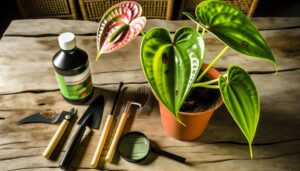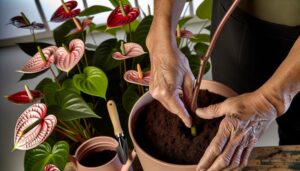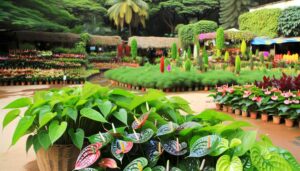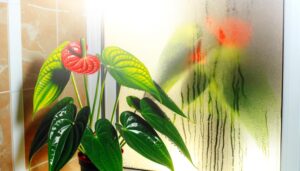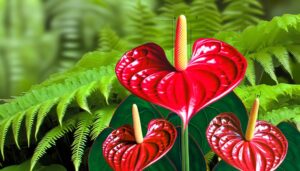10 Steps to Perfect Anthurium Cut Flower Cultivation
To nurture impeccable anthurium cut flowers, start by selecting Anthurium andraeanum for its durability. Maintain 70-85°F and provide bright, indirect light.
Use well-draining soil with pH 5.5-6.5 and verify the soil is sterilized. Plant at proper depth and water when the top inch is dry, using containers with drainage holes.
Diffuse light with shade cloths and provide 12-14 hours of illumination. Keep temperatures stable and humidity at 70-80%.
Regularly inspect and manage pests using natural predators or insecticidal soaps. Harvest when spadix is 2/3 open and store flowers in cool, shaded areas.
There are several essential practices to master.
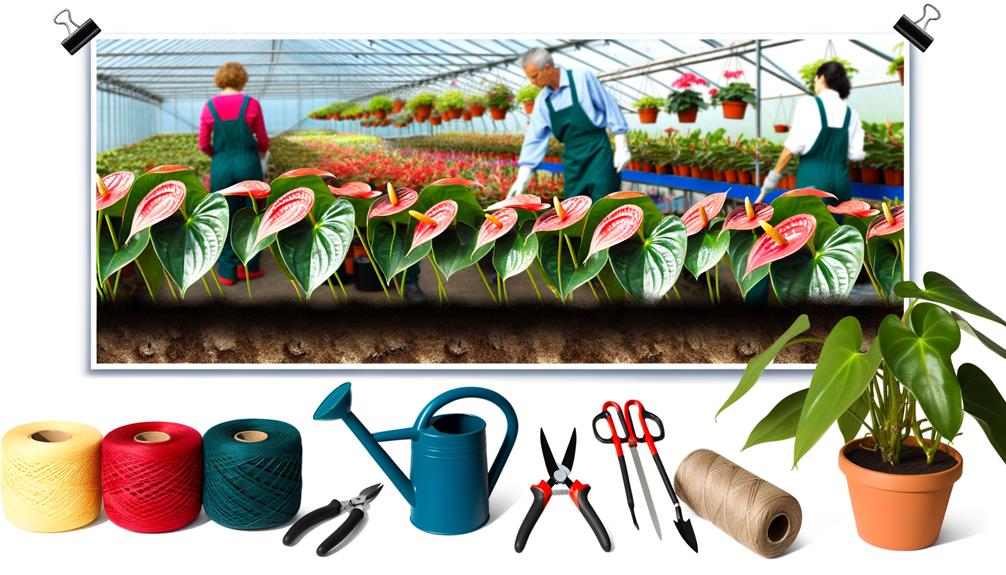
Key Takeaways
- Select disease-free, high-quality Anthurium andraeanum planting material from reputable suppliers.
- Maintain temperature between 70-85°F and provide bright, indirect light for optimal growth.
- Use well-draining, high-organic matter soil with a pH of 5.5-6.5.
- Water consistently when the top inch of soil is dry, using containers with drainage holes.
- Regularly inspect for pests and use insecticidal soaps or neem oil as preventive measures.
Choosing the Best Varieties
When selecting the best Anthurium varieties for cut flower cultivation, consider factors like bloom longevity, stem strength, and color vibrancy to guarantee market demand and profitability.
Opt for varieties like ‘Anthurium andraeanum' known for its durable blooms and robust stems. Evaluate the inflorescence for uniformity and resistance to bruising. Choose cultivars with high pigment concentration in the spathe, ensuring vibrant colors that catch buyers' eyes.
Examine genetic traits for disease resistance to minimize crop loss. Prioritize varieties with a long vase life, typically exceeding two weeks, to meet consumer expectations.
Don't overlook the importance of selecting disease-free, high-quality planting material from reputable suppliers to avoid potential cultivation issues down the line.
Optimal Growing Conditions
To achieve peak growth for your anthurium cut flowers, maintain a temperature range between 70-85°F.
Guarantee they receive bright, indirect light to prevent leaf scorching and promote vibrant blooms.
Regularly monitor and adjust environmental conditions to suit these specific requirements.
Ideal Temperature Range
Maintaining an ideal temperature range between 70°F and 85°F is important for the robust growth and vibrant blooms of Anthurium cut flowers. You should monitor the temperature consistently using a reliable digital thermometer.
During the day, aim for 75°F to 80°F, which promotes prime photosynthesis and nutrient uptake. Night temperatures shouldn't drop below 70°F to avoid stress and stunted growth. Utilize heating mats or space heaters in cooler climates and ensure proper ventilation to prevent overheating.
Sudden temperature fluctuations can cause shock, leading to poor flower development. By maintaining a stable, warm environment, you'll encourage healthy foliage and prolific flowering, ensuring top-quality Anthurium cut flowers ready for the market.
Proper Light Requirements
Ideal light conditions for Anthurium cut flower cultivation require bright, indirect sunlight for approximately 10 to 12 hours daily. Direct sunlight can scorch the leaves, so you should place your plants in a location with filtered light. Alternatively, you can use grow lights to supplement natural light, making sure they receive enough illumination.
To optimize light exposure, consider the following:
- Use sheer curtains: These diffuse sunlight, preventing leaf burn.
- Rotate plants: Make sure plants receive uniform light exposure by turning them regularly.
- Monitor light intensity: Use a light meter to maintain the ideal range between 10,000 and 20,000 lux.
- Adjust seasonal lighting: Increase artificial light during shorter days to maintain consistent growth.
Following these guidelines will support healthy Anthurium growth and vibrant blooms.
Soil Preparation
Begin by selecting a well-draining, high-organic matter soil mix to promote robust growth and prevent root rot in your Anthurium cut flowers. Opt for a mixture containing materials like peat moss, pine bark, and perlite. These components guarantee adequate aeration and moisture retention.
Sterilize the soil to eliminate pathogens by heating it to 180°F for 30 minutes. Verify the pH level of the soil is between 5.5 and 6.5, as Anthuriums thrive in slightly acidic conditions. Test the soil's nutrient levels and incorporate a balanced, slow-release fertilizer if necessary.
Regularly monitor soil moisture, making sure it remains evenly moist but not waterlogged. Proper soil preparation sets the foundation for healthy Anthurium growth and vibrant cut flowers.
Planting Techniques
When planting Anthurium cut flowers, make certain you place the root ball at the same level it was growing previously to prevent stress and promote acclimatization.
Select a well-draining potting mix with organic matter to guarantee proper aeration and moisture retention.
Gently spread the roots in the planting hole, making sure they're not cramped or damaged.
Firmly press the soil around the root ball to eliminate air pockets, which can hinder root development.
- Root Ball Depth: Match the original growing level to prevent transplant shock.
- Soil Choice: Opt for a loose, well-draining mix rich in organic matter.
- Root Placement: Spread roots gently to avoid damage and promote growth.
- Soil Firmness: Press soil around roots to remove air pockets.
Watering Guidelines
When watering your Anthurium cut flowers, maintain ideal moisture levels without oversaturation. You should water them once the top inch of the soil feels dry, but always check for proper drainage to prevent root rot.
Utilize a well-draining potting mix and containers with sufficient drainage holes to achieve the best results.
Optimal Watering Frequency
To maximize growth and longevity of your Anthurium cut flowers, maintain a consistent watering schedule that keeps the soil evenly moist but not waterlogged. Guarantee you're checking soil moisture regularly, as overwatering can lead to root rot while under-watering stresses the plant.
- Frequency: Water every 2-3 days during the growing season. Adjust based on humidity and temperature.
- Method: Use lukewarm water to avoid shocking the roots.
- Soil Monitoring: Insert your finger about an inch into the soil; if it feels dry, it's time to water.
- Humidity Consideration: Mist the foliage to replicate the humid conditions these tropical plants thrive in.
Always water in the morning to allow excess moisture to evaporate throughout the day.
Proper Drainage Techniques
Securing proper drainage is crucial to preventing waterlogged soil and root rot in your Anthurium cut flowers. Begin by using a well-draining potting mix, ideally one containing perlite, orchid bark, and peat moss. Place a layer of gravel or small stones at the bottom of the pot to improve drainage.
Make certain the pot has adequate drainage holes to allow excess water to escape. When watering, do it thoroughly but make sure the water drains completely from the pot. Avoid letting the pot sit in standing water. Regularly check the soil's moisture level, and water only when the top inch feels dry.
Consistent monitoring and effective drainage will maintain healthy roots and vibrant blooms.
Fertilization Tips
Proper fertilization is crucial for promoting vibrant blooms and healthy growth in anthurium cut flowers. Use a balanced, water-soluble fertilizer with an N-P-K ratio of 3:1:2 to guarantee nutrient availability. Apply it every two weeks during the growing season, reducing frequency in dormant periods. Always water the plants before fertilizing to prevent root burn.
Dilution: Mix fertilizer at half the recommended strength to avoid over-fertilization.
Micronutrients: Confirm the presence of essential micronutrients like magnesium, calcium, and iron in your fertilizer.
pH Balance: Maintain soil pH between 5.5 and 6.5 to optimize nutrient uptake.
Organic Options: Consider using organic fertilizers like compost tea or fish emulsion for a sustainable approach.
These guidelines will help you achieve lush, thriving anthurium plants.
Light Requirements
You should provide Anthurium plants with bright, indirect light for best growth. Aim for a light intensity of 10,000 to 20,000 lux to mimic their natural rainforest understory environment.
Maintain a daily exposure duration of about 12 to 14 hours, using supplemental lighting if necessary to achieve this.
Ideal Light Intensity
Peak anthurium cut flower cultivation demands maintaining light intensity between 15,000 and 20,000 lux to guarantee robust growth and vibrant blooms. You need to measure and adjust the light levels in your greenhouse or growing area to meet these specific requirements.
Use a light meter to regularly monitor light intensity, making sure it stays within the ideal range. If natural light is insufficient, supplement with artificial grow lights.
- Light Diffusion: Use shade cloths to evenly distribute light and prevent hotspots.
- Light Quality: Ensure a balanced spectrum, focusing on red and blue wavelengths.
- Light Positioning: Adjust the height and angle of lights for uniform coverage.
- Light Adjustment: Modify shading and light sources based on seasonal changes.
Duration of Exposure
How long should anthuriums be exposed to light each day to ensure ideal growth and flowering?
You should guarantee anthuriums receive 12-14 hours of light daily. Use a combination of natural and supplemental lighting to meet this requirement. Position your plants where they can get bright, indirect sunlight. If natural light is insufficient, employ fluorescent or LED grow lights to maintain consistent exposure.
Monitor the light levels with a light meter, aiming for 1,500-2,500 foot-candles. Adjust the distance between the light source and the plants to avoid leaf scorching.
Consistency in light duration promotes vigorous growth and maximizes flower production. Remember, abrupt changes in light exposure can stress the plants, so adjustments should be gradual.
Temperature Control
Maintaining ideal temperature levels is important for the strong growth and colorful blooms of Anthurium cut flowers. Aim to keep the temperature within the prime range to guarantee your plants thrive.
Here's what you need to focus on:
- Daytime temperatures: Maintain between 78-85°F (25-29°C) for maximum growth and vibrant blooms.
- Nighttime temperatures: Ensure a range of 70-75°F (21-24°C) to promote consistent development.
- Humidity levels: Keep relative humidity around 70-80% to prevent dehydration and stress.
- Temperature fluctuations: Minimize sudden changes to avoid shocking the plants, which can hinder growth and bloom production.
Pest Management
Effectively managing pests in Anthurium cut flower cultivation requires a multifaceted approach to identify, prevent, and control common intruders like aphids, thrips, and mites.
First, regularly inspect your plants for early signs of infestation, using a magnifying glass to detect tiny pests. Maintain proper sanitation by removing fallen leaves and debris, which can harbor pests.
Introduce natural predators such as ladybugs for aphids or predatory mites for thrips. Use insecticidal soaps or neem oil as a preventive spray, guaranteeing thorough coverage on both sides of leaves.
Implement sticky traps to monitor and reduce flying pests. Finally, rotate chemical treatments to prevent resistance, and always follow label instructions to avoid phytotoxicity and ensure plant safety.
Harvesting Flowers
After ensuring your Anthuriums are pest-free, you'll need to focus on the best timing and technique for harvesting the flowers to maximize their quality and vase life. Begin by selecting flowers when the spadix is two-thirds to three-quarters open, ensuring ideal maturity.
Use sterilized pruning shears to make a clean cut at a 45-degree angle about 1-2 inches above the soil line. Immediately place the cut flowers in clean, lukewarm water to prevent wilting and promote hydration.
Choose early morning or late afternoon for harvesting to avoid midday heat stress.
Handle stems carefully to prevent bruising and damage.
Store harvested flowers in a cool, shaded area until ready for arrangement.
Regularly change the water in storage containers to maintain freshness.
Conclusion
You're now equipped to cultivate stunning anthurium cut flowers. Remember, anthuriums can bloom year-round, providing up to 6 million flowers per hectare annually.
By choosing the best varieties, maximizing growing conditions, and following precise planting and care techniques, you'll achieve peak yields. Keep an eye on light, temperature, and pests to guarantee healthy growth.
With dedication and attention to detail, your anthuriums will thrive and impress, showcasing your expertise in floral cultivation.

